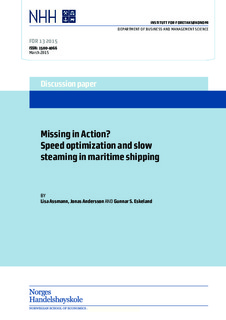Missing in Action? Speed optimization and slow steaming in maritime shipping
Working paper

Åpne
Permanent lenke
http://hdl.handle.net/11250/279033Utgivelsesdato
2015-03-12Metadata
Vis full innførselSamlinger
- Discussion papers (FOR) [566]
Sammendrag
This paper analyzes the claim, made by both academics and by industry insiders, that vessels speed
up under conditions of high freight rates and low bunker prices. The rationale for the claim is that
a ship should move slowly when high bunker prices make energy cost savings great and when the low freight rates give little temptation to rush for the next transport job. The analysis is based on the theoretical model for speed optimization by Ronen (1982) applied to AIS1 data on actual speeds of all VLCCs2 leaving from the Persian Gulf to main destinations in Japan, South Korea, China from 2006 to 2012. We find some support for the theory, however with elasticities, both for freight rates and bunker prices, of smaller magnitude than expected. We also find that speed optimizing behaviour is much more pronounced on backhaul trips than on laden trips and that the speed on trips to Japan is almost completely insensitive to changes in freight rates and bunker prices. Our conclusion is that there is a potential for gains from more adoption of slow steaming.